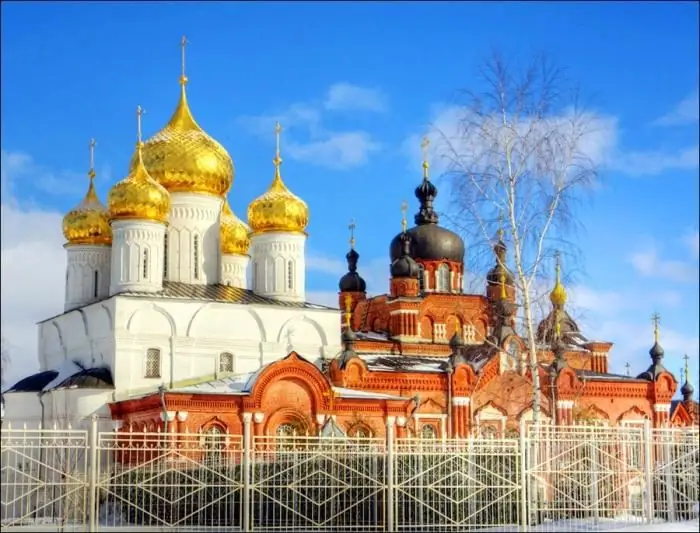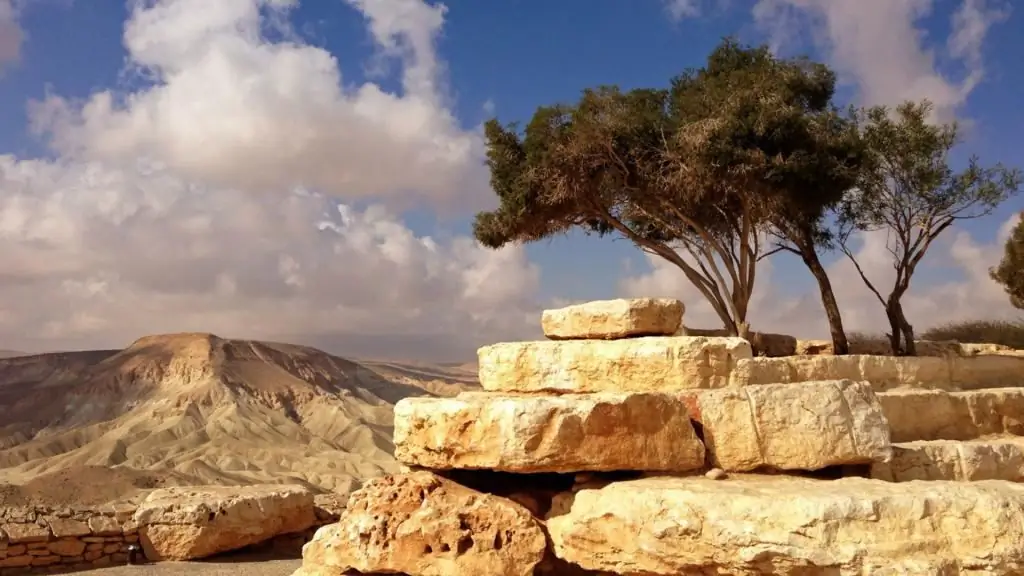- Author Harold Hamphrey [email protected].
- Public 2023-12-17 10:06.
- Last modified 2025-01-24 11:10.
The Tyumen region, figuratively called the "Gate of Siberia", together with two autonomous regions (Yamal-Nenets and Khanty-Mansiysk) stretches from the Arctic Ocean to the border of Russia with Kazakhstan and is the country's largest oil and gas producing region. In addition to minerals, it has the largest water reserves - rivers, lakes and thermal springs, as well as the third largest forest resources in the country. The magnificent nature and sights of the Tyumen region are very suitable for starting to explore Siberia.

Tyumen
Founded by decree of Tsar Fyodor Ioannovich in 1586 on the old settlement that belonged to the Tyumen Khanate. The wooden fortress of the first Russian city in Siberia was founded by the Cossacks on the high bank of the Tura to defend the eastern borders of the state and howan outpost for the development of Siberia.
Scientific, industrial and cultural center of the region. The combination of historical monuments and urbanism gives a special atmosphere to the city. The population of Tyumen is about 700 thousand people, most of whom are under 35 years old. A magnificent view of the modern city opens from the cable-stayed pedestrian bridge across the Tura, which has a 4-level embankment.
Walking through the city center, its residents and guests enjoy visiting the world's only Square of Siberian cats, which were taken to besieged Leningrad to get rid of rats, with 12 cast-iron and gold-painted sculptures of charming fluffy animals in various characteristic poses on pedestals.
You can get acquainted with the sights of the Tyumen region by visiting its museums and architectural monuments, many of them are of federal importance. This is the oldest monastery in Siberia, the Holy Trinity Monastery in Tyumen, founded in 1616 by the monk Nifont, who came from Kazan. Peter I granted 1 thousand rubles for the construction of a shrine in the Russian and Siberian style.

Natural attractions of the Tyumen region are represented by numerous hot thermal springs, different in their unique composition and temperature. The most popular are located 11 km from the regional capital in the town of Verkhny Bor. There is a legend that the conqueror of the Siberian lands, Ataman Yermak, with his army gained strength and he alth here. The well for the release of healing mineral waters was drilled to a depth of 1233 m in 1985. At anyduring the year, the temperature of the spring does not drop below +40°, and around it there is a popular recreation center with two swimming pools.

One of the sights of the Tyumen region is the wonderful lake Bolshoy Taraskul (translated from Tatar - “lake of horseflies”), 14 km from the city of Tyumen with an area of 1.5 square meters. km. Part of the coast is sandy and dry, and part is swampy. The lake is filled with sapropel - centuries-old bottom reserves of therapeutic mud of high biological activity and is a natural monument of local importance. It is no coincidence that a large balneological he alth resort of federal significance for 850 people is located here.

Tobolsk
Tobolsk - a city-monument far from highways - was founded in 1587 and became a Siberian trade point on the way from the center of the country to Central Asia and China. From here, education, science, Orthodoxy, crafts and stone construction spread to Siberia. Lost the status of a provincial city in the 1820s. in connection with the removal of trade routes and the railway from it. Today it is a unique center of educational tourism.

A monument of federal significance, the only one in the Trans-Urals, the Tobolsk Kremlin is what every traveler needs to see in the Tyumen region. It was built of stone for 100 years from 1700 on the site of wooden predecessors on the high 60-meter Troitsky Cape with a magnificent view of the river. Irtysh. An old paved road leads from the foothills to the Kremlin - Sofiavzvoz - fortified with high brick walls.
The structure of the modern Kremlin includes:
- St. Sophia Cathedral;
- 2 bell towers;
- Intercession Church;
- bishop's house;
- monastic building;
- gostiny dvor;
- consistory;
- rentery;
- belfry;
- walls with towers;
- prison castle.
Near the Kremlin you can see the Church of the Holy Trinity in neo-Gothic style, built for exiled Poles and Lithuanians in 1907. The Tobolsk region gave Russia many outstanding people: chemist D. I. Mendeleev, poet-storyteller P. P. Ershov, composer A. A. Alyabyev, artist V. G. Perov. Since the 1830s there were exiled Decembrists in the settlement in Tobolsk, many of whom did not have a chance to see their native places.
Ishim
The history of the country begins with the history of provincial towns. In 1721, at the behest of Peter I, the Ishim district center became such a city, which grew out of Korkina Sloboda. The holding of the annual All-Russian Nikolskaya Fair, the construction of stone and wooden churches, numerous merchant houses and estates made this city a county one. More than 40 architectural monuments have survived to this day. The cultural center of the city is the Ishim Museum of Local History, which has collected a rich collection of fine arts and archaeological finds, evidence of merchant life, political events in the region, including the anti-Bolshevik uprising of 1921. The museum is located in a building of the 19th century, built at the expense of a local merchant and philanthropist N. M. Chernyakovsky.
Abalak
The village is located 25 km from Tobolsk on the banks of the Irtysh and was Tatar before the annexation of Siberia to Russia. The place of the decisive battles between the troops of the Cossack chieftain Yermak and the Tatar prince Mametkul. There are male and female monasteries, famous for miraculous icons. A popular place in the Tyumen region for tourists of all ages, it attracts with its historical complex with wooden buildings in the old Russian style: a fortress, chambers, a tavern, near which fascinating reconstructions of the Abalak Field battles are held every year.

Grigory Rasputin Museum
A very popular and unusual museum was created by the Smirnovs in the village of Pokrovsky, 80 km from Tyumen, in the homeland of the "great old man" and became the first private museum in the Soviet Union. Unique exhibits are associated with the legendary personality of Rasputin, who was killed in 1916 by his family, and create a unique mystical atmosphere. One of the rarities - a genuine Viennese chair of an old man - according to a legend prevailing among the people, has healing properties. Tours are conducted by the owners of the museum themselves and none of the visitors are left indifferent.

S alty Lake
A shallow lake called the "Dead Sea" is located in the Berdyugsky district near the village of Okunevo. An attraction of the Tyumen region, known far beyond its borders, the lake is popular with tourists as a free balneological resort due to its highly mineralized, bitter-s alty taste.water and medicinal mud. Next to it, through a natural 50-meter spit, you can see the fresh Long Lake, suitable for fishing.
Maryino Gorge
Located in the Isetsky district in the south of the region on 27 thousand hectares of the ancient terrace of the river. Iset with unique fauna and flora listed in the Red Book, remains of ancient cemeteries and settlements. Due to numerous folk legends, the place became sacred and is associated with the death of participants in the Civil War here. The ravine is perfect for a geocaching game, and against the background of the floodplain, hikers usually take beautiful photos of the sights of the Tyumen region. in the village of Isetsky you can visit the folk museum of local lore.
Nigmatulla Hadji Mosque in Yembayevo
When planning excursions in the Tyumen region, one cannot help but visit the village of Embaevo, 18 km from Tyumen, representing Muslim Siberia and founded by Bukhara merchants who came to trade in fabrics, leather goods, dried fruits and spices. In 1884, the merchant and philanthropist Nigmatulla Karmyshakov-Saydukov financed the construction of a mosque and a religious school designed by a Lutheran from Prussia, Gottlieb Zinke. The Islamic complex also includes a hotel, a library, a kitchen and a dining room.
After the devastating fire that happened in the village, the philanthropist built 176 houses for local residents. Nigmatulla Khadzhi Karmyshakov-Saydukov was buried in the village cemetery in 1901. In the strict and elegant architectural form of the mosque, a successful combination of principles can be tracedconstruction of Muslim and Orthodox religious buildings.

Reviews of tourists
The embankment and the bridge of lovers in Tyumen are magnificent. In the evening, everything is lit up and creates a festive mood. In general, the city has parks where you can relax, take a walk with children and ride attractions.
Tourists enjoy visiting the original Rasputin Museum, where you can learn a lot of interesting things about this man. According to their reviews, the collection of photographs of the elder and books about him is especially striking. The museum is very popular not only among ordinary visitors, but also among celebrities.
Various cultural and natural sights of the Tyumen region in the photo with a description of excursion routes will help to plan leisure activities for both lovers of educational travel and supporters of eco-tourism, hunting and fishing.






